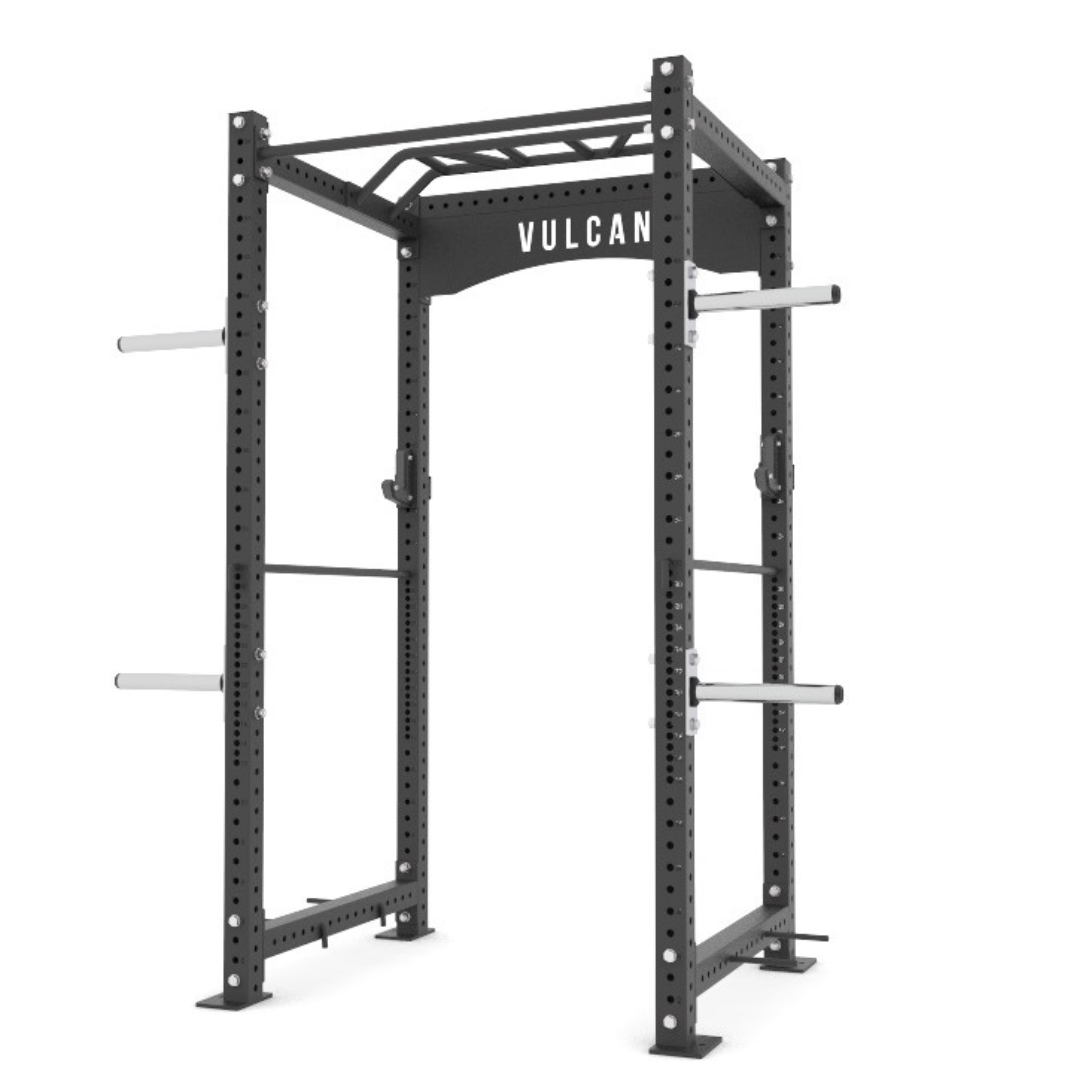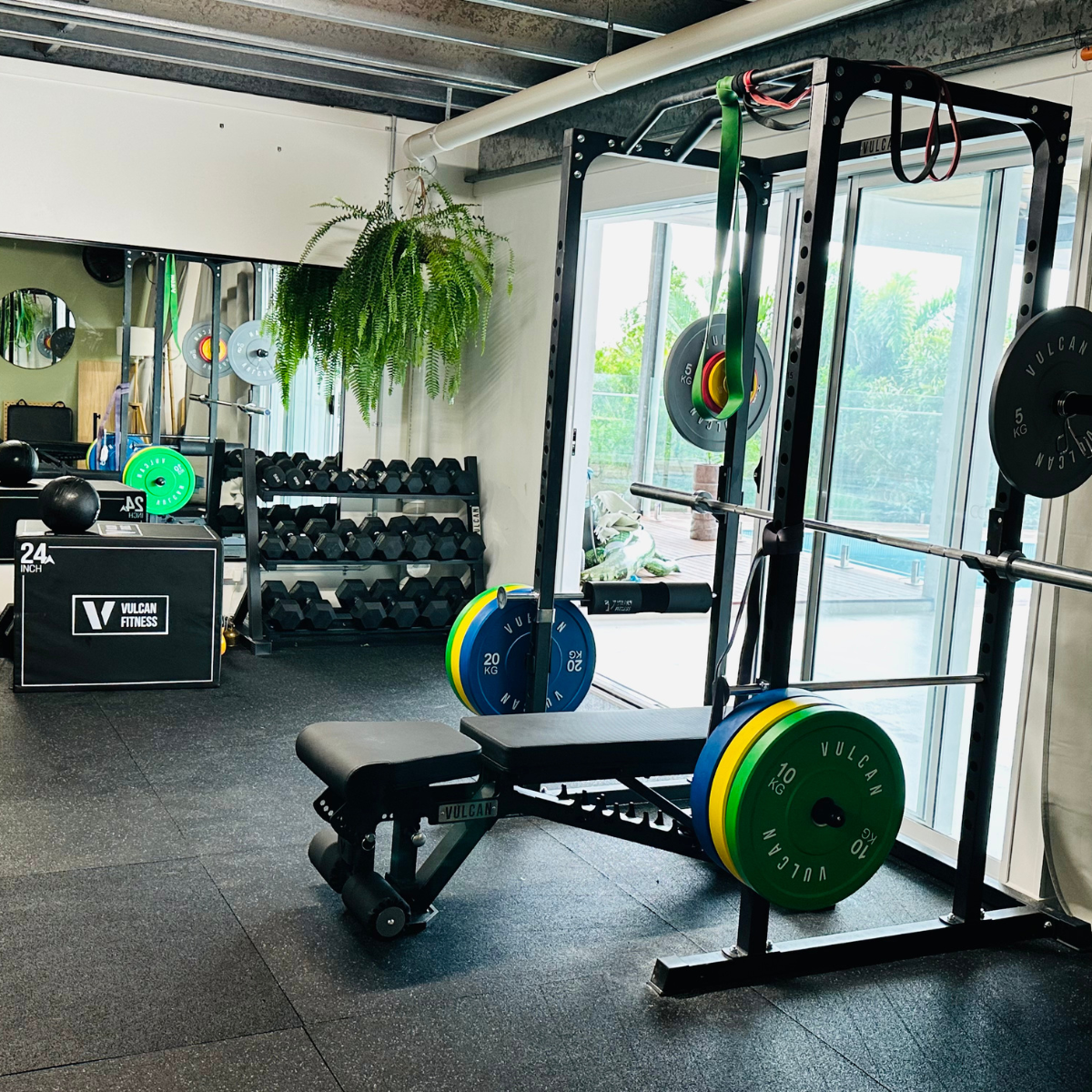The VULCAN No-Nonsense Rack Buying Guide
A rack is the cornerstone of any home gym and will be one of the most important purchases you make. It forms the base that allows you to safely train key compound lifts, including squats and bench press (plus many more of course). With a huge range of different models on the market with widely varying prices it can be difficult to know where to start. We have developed our no-nonsense rack buying guide to cut through the bull and point you in the right direction.
Different types of racks
First let's give a brief overview of the three main different types of rack:
- Power Rack/ Power Cage. A power rack features four (4) steel uprights forming a cage that surrounds you while you lift.
- Squat Rack. A Squat rack features two (2) steel uprights which effectively forms half a cage.
- Squat Stands. A squat stand is a good budget and space saving option. It consists of two uprights, which may or may not be joined together depending on the model.
Power Rack/ Full rack
A power rack features 4 steel uprights forming a cage that surrounds you while you lift. A key feature of the power rack are the horizontal safety bars that can be adjusted to act as your spotter. This is especially important if you are working out at home by yourself.
Advantages:
Safety – safety bars and increased stability from 4 uprights means a power cage is generally the safest option when training without a spotter.
Versatility – power racks have a wide range of attachments available, including landmine, dip and lat/row attachments. Your rack can be configured and customised to give you access to almost unlimited variations and exercises.
Disadvantages:
Space required – the footprint of a power cage is generally larger than that of a squat rack or stand
Price – generally power racks use more steel than other types of racks, and more steel means a pricier option. That being said, good squat racks can be more expensive, as the two post design means more heavy duty uprights are required to maintain similar levels of stability. If you are after a great value power cage checkout the VULCAN Home Gym Power Cage 😉).

VULCAN Home Gym Power Rack
The VULCAN Home Gym Home Rack is insane value for money and makes a fantastic centrepiece in any home gym. With a range of compatible attachments, this power rack gives you the versatility to perform hundreds of different exercises from the comfort of your own home.

VULCAN Commercial Power Rack
The VULCAN Commercial Power Rack is our top of the line power rack allowing for virtually limitless configurations and attachment setups. This rack is the ultimate cornerstone of any home/commercial gym, with versatility and range of attachments to perform hundreds of exercises. Designed to stand anything you can throw at it with a rackable capacity over 500kg and lifetime warranty on the frame. Best of all, you won't find a better price for a top of the range offering from any of our competitors.
Squat rack
Squat rack features 2 steel uprights which effectively forms half a cage. Exercises are performed in front of the rack. Good squat racks are made with more heavy duty steel (more on this below) to increase the stability of the rack. Most squat racks will include safety spotter arms that extend past the front of the rack. While a good design will offer great protection from failed reps, a light/poorly designed rack may offer limited protection. If the rack is not heavy enough, it may tip over when failing a rep at high weight. It is recommended to bolt a squat rack to the floor if possible, especially if you will be lifting heavy.
Advantages:
Space required – Generally take up less room than a power cage.
Range of motion – Lifting in front of the uprights means you are not restricted by overhead bars of a power cage. This may be beneficial when performing overhead movements or Olympic style lifting.
Safety – While generally not considered as safe as a power cage, a well-made squat rack will provide a fantastic base to perform your key exercises.
Disadvantages:
Versatility – while there are plenty of attachments available for the squat rack to increase versatility of exercises, the range is not as extensive as a power rack.

VULCAN Elite Squat Rack
Have you ever attempted a pull-up or heavy squat on a cheap, rickety squat rack and felt like it could fall apart any minute? This is NOT one of those racks!
The VULCAN Elite Squat Rack delivers maximum stability through smart design combined with heavy duty 3x3" 14 gauge steel, and comes with a LIFETIME warranty on the frame. Found in both commercial and garage gyms around Australia, this rack offers great versatility when training for strength, size, or functional fitness and can be combined with additionalVULCAN Elite Squat Rack Attachments.
Squat stands
A squat stand is a good budget and space saving option. It consists of two uprights, which may or may not be joined together depending on the model. There is no pullup bar and generally very limited options to add additional attachments. While it is the cheapest options, it does not offer much in terms of safety features, and we would recommend using a spotter.
Advantages.
Price – Squat stands the the cheapest option available.
Space Saver – Easily has the smallest footprint of all the different racks. Great option if you only have limited space (or height) available. If the two uprights are not connected, a squat stand can be easily stored in a cupboard
Disadvantages.
Safety – Squat stands do not offer much in the way of assistance should you fail a rep. A spotter is recommended when performing heavy lifts.
Versatility – limited ability to add attachments

VULCAN Elite Squat Stands
Introducing our all NEW VULCAN Elite Squat Stand, extremely stable and a great alternative if you're looking for stand to just get started at your home.
Can be adjusted to perform almost all exercises that you could do in a standard rack.
What to look for when buying a rack?
Now we have the basics out of the way, let’s look at the key elements to look for when evaluating a rack:
- Weight rating. It is important to consider the weight rating of a rack.
- Quality of build. While the type of steel gives an indication of the stability of the rack, it is also important to consider the build quality.
- Rack features. When looking at a rack, there are a number of features, which, while not 100% necessary, are important considerations.
Weight rating
It is important to consider the weight rating of a rack. First, look at a) the thickness (or gauge) of steel and b) the upright dimensions being used in a rack. A general rule to use is the higher the physical weight of the rack, the more stable it will be (note this is not a hard and fast rule – build quality is an important factor which you we get into below). It will also mean that the rack is likely to be more expensive, as more steel = higher cost.
Thickness or gauge of the steel. The thickness of the steel uprights significantly effects the stability of a rack. Retailers refer to thickness of the steel by referencing the thickness in millimetres or referring to the gauge of the steel.
Sidenote: the use of gauge as a measure of thickness goes back to the start of the industrial revolution – confusingly it works backwards – the higher the gauge the thinner the steel. Here at VULCAN we stick to mm when listing our products – our slow brains find it much simpler to think in millimetres.
The most common thickness of steel ranges from 2mm (14 gauge) to 3mm (11 gauge). Any thinner and you start compromising on stability and safety. Any thicker and you hit diminishing returns – that is the extra cost is not worth the slight increases in stability/ durability apart from in the busiest commercial facilities.
While 1mm difference in thickness doesn’t sounds like a lot, this drastically changes the stability and weight rating of a rack. At VULCAN, our commercial power cage and rigs use 3mm steel uprights. These are both suitable for commercial use and are designed to hold way more weight than any of us can possibly lift.
Our Home Gym Power Rack and Elite Squat rack use 2mm thick steel. Our home gym power cage is engineered to use the minimal amount of steel yet still provide a sturdy base to perform squats, pull ups and all your other lifts (weight rating of 320kg). The minimal use of steel ensures the rack is great value for money, without compromising safety. While primarily intended for home use, it is used at several commercial facilities around Australia. It is also used by many personal trainers as the cornerstone of their personal studios to train clients.
Upright dimensions.If you see figures like 70mm x 70mm for rack dimensions, this refers to the width and depth of an upright. Generally speaking, the bigger the dimensions, the more stable the rack will be, however you must also take into consideration the thickness/gauge of the steel is arguably more important.
Our commercial power rack, elite squat rack, and rig uprights all have a upright dimension of 75x75mm.
At Vulcan we do not sell a squat rack with dimensions of less than 75x75mm. Safety is an absolute key feature of any rack, and we have yet to see a design of a squat rack that feels sturdy enough to give us the confidence to lift big.
Quality of build
While the type of steel gives an indication of the stability of the rack, it is also important to consider the build quality. The integrity of the welds and joins on a rack plays a big part – there is no use having tank like steel only for the rack to fail at a weld. As a general rule, look at a brands reviews, warranties and the price – often what you pay for is what you get. At VULCAN we rigorously vet all our manufacturers and uphold strong QA procedures to ensure our racks meet stringent quality and safety standards. Our manufacturers also supply some of the biggest and most reputable companies worldwide.

Rack features
When looking at a rack, there are a number of features, which, while not 100% necessary, are important considerations.
Hole spacing – Some racks, including our commercial power cage and elite squat rack have what is known as Westside Hole Spacing. This means there is only 1" (or) 2.5cm between the holes and allows for the precise placement of safety arms and J-Hooks, a particularly useful feature when setting up your rack for bench pressing.
Laser engraved numbering – Numbers engraved next to the holes on both sides of the rack. A small but useful feature which mean you spend less time adjusting your J-hooks and safety bars, and ensures you use the optimal setup for your lifts.
Available attachments – Consider what attachments you might want to get either now or in the future, and if they are compatible with your rack.



















